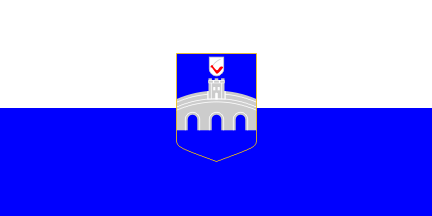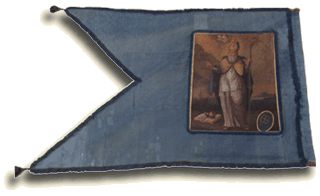
image by Željko Heimer, 1 November 2009

Last modified: 2010-02-12 by dov gutterman
Keywords: osijek | osjecko-baranjska | osijek baranja |
Links: FOTW homepage |
search |
disclaimer and copyright |
write us |
mirrors

image by Željko Heimer, 1 November 2009
See also:
Other sites:
The coat of arms is basically the same as the one granted in
1809 by king Francis I, today in much simplified form. In blue
field a silver bridge with a tower, above it an escutcheon Argent
an Arm embowed Gules holding a Sabre proper. The coat of arms
bordered golden is set in the middle of a landesfarben
style flag of white over blue bicolour. The colours are those
from the coat of arms. The flag is also used in long vertical
version, occasionally without the coat of arms, too. The flag was
used in such way much before 1990's.
Željko Heimer
Recently, the city updated its decision
on the use of the coat of arms and the flag, therefore providing
for the more data on the adoption documents (since the official
gazettes are available on-line only since late 1996): Odluka o
izmjenama Odluke o uporabi grba, zastave, imena i svecane pjesme
Grada Osjeka, 21.07.2009, Službeni glasnik Grada Osijeka,
br. 9/2009, 22.07.2009..
This decision introduced but minor changes in the original 1995
decision wording (reflecting the change of the administrative
organization of the city, granting more responsibilities to the
Mayor), however, it provides the full name of the original
decision: Odluka o uporabi grba, zastave, imena i svecane pjesme
Grada Osjeka, Službeni glasnik Grada Osijeka, br. 1/95 and
therefore setting the adopting date of the current coat of arms
and flag into 1995.
Looking at the city Statutes available on-line there are 1997 Statute
consolidated text of 1994 Statutes with one 1995 and one 1996
update: Statut Grada Osijeka (procišceni test),
Službeni glasnik Grada Osijeka, br. 5/97.
The 2001
Statutes, replacing the 1997 text contains word for word
equal Article 5 that describes the coat of arms, seal, flag,
ceremonial mayor's chain and anthem: Statut Grada Osijeka,
25.09.2001, Službeni glasnik Grada Osijeka, br. 6/2001.
The 2003
amendments to it introduce only very minor change -
mentioning now also symbols of the national minorities among the
things (i.e. city coat of arms, seal, flag, chain, anthem) to be
determined with a further decisions on their use, and adding
Article 5a granting the right to the members of minorities to
display their national symbols, provided that they display the
national symbols of Croatia beside them. Statut o izmjenama i
dopunama Statuta Grada Osijeka, 22.04.2003, Službeni glasnik
Grada Osijeka, br. 3/2003.
I suspect that the coat of arms and the flag were adopted either
by the 1995 amendments to the 1994 Statutes or by some other 1995
decisions, which was followed by the mentioned 1995 decision
regulating their usage.
In any case, it may be useful to consider the entire text of the
Article 5 where it concerns coat of arms and flag:
Paragraph 2 of the Article 5 states: "The coat of arms of
the City of Osijek is in stylized shield shape with height to
width ratio 5:4. In its central part is highlighted a bridge with
three arches over the Drava river. In the centre of it, a
rectangular tower is raising with three embattlements, two
windows and a single rectangular door. Above the central
embattlement is a smaller shield containing an arm holding a
sabre. The four basic colours of the coat of arms are:
cobalt-blue, vermilion-red, golden and silver. The area above and
below the bridge and the tower is cobalt-blue. The hand in the
smaller shield and the outline of the fist are vermilion-red. The
outlines of the coat of arms and the fist in the smaller shield
are golden. The bridge, tower, outline of the smaller shield and
the sabre are silver". This is follower by paragrah 3:
"The prototype of the coat of arms is made in multicolour
ceramo-plastics technique, 50 cm high."
If you follow this description closely, you may notice that the
colour of the smaller shield is not mentioned and that would
suggest - to me - that it should be blue, however, it seems that
in all depictions this shield is shown with white field. Of
course, the description above does not menton white at all, and
the standard depctions (that may or may not be much similar to
the mentioned prototype!) use both silver-grey and white colour
to show varous elements of the coat of arms. The precribed detail
of the fist to be golden with red outline is, as a rule, so small
that it is hardly possible to notice it. The golden outline of
the shield is, of course, a heraldic nonsence, and even if it is
shown with that outline on the flags as a rule, the coat of arms
when shown on its own often omits that outline.
Anyway, the flag is described in the paragraph 5: "The city
of Osijek has its flag. The colours of the flag are white and
cobalt-blue. The ratio of the length and width of the flag is 2:1
and the colours are set perpendicularly to the staff, so that the
white is at the top of the staff, and if the flag is hoisted
without the staff, then the white is on the left side, looking at
the flag. In the center of the flag is the coat of arms of the
city of Osijek. The height of the coat of arms to the height of
the flag is 1:4. The ceremonial flag of the City of Osijek is
produced of white and cobalt-blue silk, and the coat of arms of
the City of Osijek in the flag is made in golden embroidery
technique on both sides of the flag."
Several issues: first a minor one, notice the different capital
used for "City" (both 1997 and 2001 texts) - I believe
have no implication at all; the ratio speaks of length and width
2:1, while the coat of arms is determined to be 1/4 of the flag
height high - immediately posing question weather the flag height
is its length (fly) or width (hoist)? I believe the length is
meant here as otherwise the coat of arms would indeed be very
small, so the coat of arms height is simply half the hoist.
The horizontal and vertical versions are clearly mentioned,
although the rotation of the coat of arms is not explicitly
mentioned, both versions are reportedly in use in Osijek. The
flag rotation for the vertical positioning is properly prescribed
("rotate 90° and flip") following the heraldic
tradition. The ceremonial flag is differing from the normal one
only by the materials and production techniques used, while
having the same design as the "normal" flag (as is the
case for several other local flags in Slavonia).
The vertical flag is often used as a very long vertically
displayed flag, as I reported earlier.
Željko Heimer, 1 November 2009

image by Željko Heimer, 1 November 2009
os-os.gif)
image by Željko Heimer, 1 November 2009
I would suggest you take a look at: <museum.mdc.hr>
with illustration from the document declairing Osijek a
"free royal city" (that is under royal protection and
with certain privileges), which is also the document that granted
the coat of arms. The current coat of arms which you can see on
the flag is based on the one from 1809.
Željko Heimer, 26 August 1999

image from the site
of the land museum of Osijek, located by Dov Gutterman,
25 August 1999
This is the site of the land museum of Osijek. The flag shown
on the mentioned page is the flag of the Bakers' Guild from year
1800.
There is no any other info on the flag there. Its shape is, I
guess, typical for the period - and based on chivalry guidons.
Blue colour may have (and then may not) reference to the city
(which traditional colour is blue), and the flag contains
painting of a saint, I guess, the patron saint of the guild (but
I couldn't tell which one). I would also guess the reverse (or
obverse, if you want) would have some other picture in that
place. There is some kind of heraldic device in the lower hoist
corner of the painted part, but I can hardly recognize what it
is.
Željko Heimer, 26 August 1999
There is flag at the
Slavonian Museum in Osijek at <www.mdc.hr>,
reported by Željko Heimer.
This is a swallow-tail flag. On the white field there is
Illiria's Coat of Arms with inscriptions in Coratian: GLAVNA
STRAŽARA NARODNE GARDE and German: HAUPTWACHE DER
NATIONALGARDE (National Guard Main Outpost). This flag was
damaged by the weather.
Milan Jovanovic, 29 April 2007